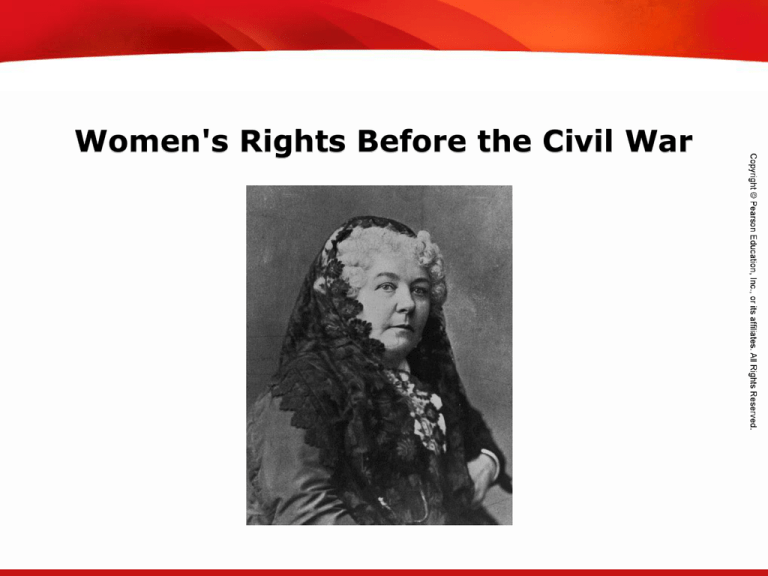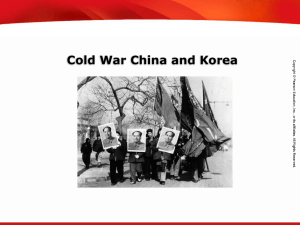section 8.4 ppt
advertisement

TEKS 8C: Calculate percent composition and empirical and molecular formulas. Women's Rights Before the Civil War TEKS 8C: Calculate percent composition and empirical and molecular formulas. Objectives • Identify the limits faced by American women in the early 1800s. • Trace the development of the women’s movement. • Describe the Seneca Falls Convention and its effects. TEKS 8C: Calculate percent composition and empirical and molecular formulas. Terms and People • matrilineal – when inheritance is passed down through the female side of the family • Sojourner Truth – former slave from New York who gave spellbinding speeches on slavery • women’s movement – movement beginning in the mid-1800s in the United States that sought greater rights and opportunities for women • Lucretia Mott – abolitionist who was angered by the lack of equality for women; co-organizer the Seneca Falls Convention TEKS 8C: Calculate percent composition and empirical and molecular formulas. Terms and People (continued) • Elizabeth Cady Stanton – abolitionist who pushed for suffrage; co-organizer of the Seneca Falls Convention • Seneca Falls Convention – held in New York in 1848, the first women’s rights convention in the United States • Amelia Bloomer – publisher of The Lily who advocated for complete equality, including in dress; long pants worn under a skirt were nicknamed “Bloomers” in her honor TEKS 8C: Calculate percent composition and empirical and molecular formulas. Terms and People (continued) • suffrage – the right to vote • Married Women’s Property Act – 1848 New York State law that guaranteed greater property rights for women; used as a model in other states TEKS 8C: Calculate percent composition and empirical and molecular formulas. What steps did American women take to advance their rights in the mid-1800s? In the early and mid-1800s, women took active roles in the abolition and other reform movements. Some also worked to gain equality for women, laying the groundwork for the equal rights struggle over the next hundred years. TEKS 8C: Calculate percent composition and empirical and molecular formulas. • Women could not own property. In the 1800s, women’s rights and freedoms rights were severely limited. • Women rarely received a formal education. • Women were deprived of the right to vote. • Women could not hold office. Women contributed to society privately by influencing their husbands and raising good children. TEKS 8C: Calculate percent composition and empirical and molecular formulas. Some cultural groups living in America, Native American, African Americans, and Mexican Americans, traditionally allowed women more power and freedom. Some were also matrilineal societies, which permitted women to inherit family property and names. Most American women were denied these rights. TEKS 8C: Calculate percent composition and empirical and molecular formulas. New opportunities for women grew from the Second Great Awakening reform movements. Many women joined churchsponsored reform groups. Women played key roles in public education, abolition, temperance, and reforming the treatment of the mentally ill. Similarities in the plight of women and of slaves led many abolitionists to support women’s rights. TEKS 8C: Calculate percent composition and empirical and molecular formulas. Famous Women Reformers • Public school movement Catherine Beecher, Emma Willard, Elizabeth Blackwell • Treatment of mentally ill Dorothea Dix • Abolition Sojourner Truth (at right); Angelina Grimké and Sarah Grimké TEKS 8C: Calculate percent composition and empirical and molecular formulas. Industrialization brought women into the workplace in the 1820s and 1830s. • Factories and mills provided the first jobs that women held outside of the home. • Though their pay was lower than men’s, and their husbands or fathers typically collected their wages, women developed a new degree of independence. By the 1830s, some women had even joined labor unions and participated in strikes. TEKS 8C: Calculate percent composition and empirical and molecular formulas. Still, little changed in the status of women until two trends coincided in the 1830s. Urban middle class women began to hire poor women to do their housework, allowing them time for activism. Women working for abolition began to compare their own condition with that of slaves. TEKS 8C: Calculate percent composition and empirical and molecular formulas. The women’s movement began when a few men and women questioned the lack of rights and opportunities for women. • In Letters on the Equality of the Sexes and the Condition of Women, the Grimké sisters argued that God made men and women equal. • In Women in the Nineteenth Century, Transcendentalist Margaret Fuller argued that men and women were intellectually equal. TEKS 8C: Calculate percent composition and empirical and molecular formulas. Two abolitionists led the call for full equality. Lucretia Mott, a Quaker, had helped found the American Anti-Slavery Society. At an abolitionist convention in London, Mott and Elizabeth Cady Stanton were outraged by the limits placed on their participation in the proceedings. Elizabeth Cady Stanton TEKS 8C: Calculate percent composition and empirical and molecular formulas. In 1848, Mott and Stanton organized the first Women’s Rights Convention in Seneca Falls, often called the Seneca Falls Convention. • Hundreds of men and women attended, including Frederick Douglass. • Delegates adopted a “Declaration of Sentiments” modeled after the Declaration of Independence. Although it produced few real changes in women’s rights, the convention marked the beginning of the women’s movement in the United States. TEKS 8C: Calculate percent composition and empirical and molecular formulas. Amelia Bloomer was so inspired at Seneca Falls that she went on to publish her own newspaper, The Lily, advocating women’s equality. She also advocated equality in dress: long pants worn under a shorter skirt came to be called “bloomers” after her. Also inspired by the convention was Susan B. Anthony, who would go on to become a leader in the suffrage movement—the most critical of all women’s political rights. TEKS 8C: Calculate percent composition and empirical and molecular formulas. In 1848, New York passed the Married Women’s Property Act, guaranteeing women property rights for the first time. This act became a model for laws enacted in other states for many years. By the mid-1800s, a new course was set. Their gains were small and slowly won, but women’s fight for equality had begun.











